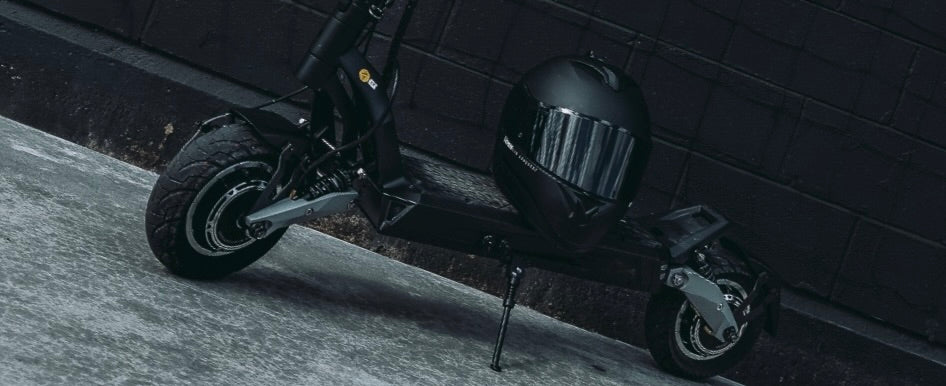Caption: The 2023 Apollo City Pro rides smoothly on tubeless, self-healing pneumatic tires
Electric scooters offer such an incredibly convenient way to get around that it’s easy to ride them without ever thinking about how they work – until something goes wrong, that is.
And unsurprisingly, flat tires are the most common problem reported by electric scooter riders – by a huge margin. If we take the wisdom about prevention and cures to heart as riders, we’ll probably want to learn how to keep our scooter’s tires in good working order.
The good news is that tire care doesn’t require a tremendous amount of know-how or expertise, and you can avoid most common tire problems with simple routines like checking tire pressure and topping off when low.
We might also tend to take tires for granted when shopping for a new electric scooter, ignoring crucial differences between them. However, the right tires can make all the difference in terms of performance, comfort, and safety.
In this complete guide, we will explore everything you need to know about electric scooter tires, helping you make an informed decision when choosing the right ones for your ride.

Caption: Segway Ninebot’s E2 uses foam-filled airless solid tires for a less vibration
A Guide to Different Types of Electric Scooter Tires
When it comes to electric scooter tires, there are several options available. The most common types are pneumatic tires with tubes, tubeless tires, airless solid tires, and honeycomb tires. Each type has its own set of advantages and disadvantages, so it's essential to understand their characteristics before making a decision.
Pneumatic Tires (Tubed)
Pneumatic tires are similar to traditional bicycle tires and require inflation with air. They offer a smooth and comfortable ride, thanks to the air-filled chambers, or inner tubes, inside that act as cushions, absorbing bumps and vibrations from the road. However, pneumatic tires are prone to punctures, requiring regular maintenance and occasional replacements.

Caption: The Apollo City uses self-healing tubeless tires for maximum comfort and shock absorption
Tubeless Tires
Tubeless tires, on other hand, function more like car tires (and increasingly more bike tires), with no inner tube to hold the air. Instead the bead of the tire forms a tight seal with the wheel rim, holding the air inside. All tubeless tires have some degree of puncture resistance, but those marked as “self-healing” contain an extra layer of sealant that heals punctures immediately so that little to no air is lost.
Meet Apollo Go: the ultimate commuter scooter with self-healing tires
Solid Rubber Tires
Airless rubber solid tires are maintenance-free but they do not provide much traction or shock absorption. Made of solid rubber, these tires eliminate fear of punctures and the need for inflation. But their lack of give isn’t worth the trade-off for most riders.

Caption: Unagi’s Model One uses vented solid tires to help dissipate the effect of small bumps in the road
Vented, Honeycomb, and Foam-filled Solid Tires
Honeycomb, vented, or foam-filled solid tires strike a balance between comfort and durability. These tires feature a unique solid structure with a series of vents or hexagonal cells that provide cushioning and shock absorption. More solid tires these days are often filled with foam for extra cushioning. With these tires, riders can enjoy a smoother ride while reducing the risk of flats.
Choosing the Right Tires for Your Electric Scooter
Choosing the right tires for your electric scooter depends on various factors such as your riding style, the terrain you'll encounter, and the desired level of comfort. If you frequently ride on rough or uneven surfaces, pneumatic tires with a larger diameter may be the best option as they provide better shock absorption. The air-filled chambers inside these tires act as cushions, ensuring a comfortable ride even on bumpy roads.
For urban commuting and smooth surfaces, airless solid tires or honeycomb tires offer a maintenance-free and reliable solution. Airless solid tires, with their solid rubber construction, are highly durable and can handle different terrains without the risk of punctures. Honeycomb tires, on the other hand, provide a balance between comfort and durability, making them a popular choice for riders who encounter a mix of smooth and uneven surfaces.
Consider your specific needs and preferences before making a decision. If you prioritize convenience and peace of mind, airless solid tires may be the way to go. On the other hand, if you value a smooth and comfortable ride, pneumatic tires or honeycomb tires might be the better option.

Caption: Fluid Freeride’s Vista is a commuter scooter with solid tires for a no maintenance option
Understanding the Pros and Cons of Pneumatic Tires
Pneumatic tires have been widely used in the electric scooter industry for their excellent shock absorption and comfortable ride. The air-filled chambers inside these tires act as cushions, absorbing bumps and vibrations from the road, resulting in a smoother and more enjoyable ride. Riders can confidently navigate through uneven surfaces, knowing that the tires will provide the necessary suspension.
However, pneumatic tires are more susceptible to flats and punctures compared to other types of tires. The air-filled chambers make them more vulnerable to sharp objects on the road, requiring regular maintenance and occasional replacements. If you frequently ride in areas with debris or rough surfaces, the risk of punctures may be a significant concern.
However, self-healing air-filled tires like those on the Apollo Pro and Apollo City Pro really do work as advertised, giving you peace of mind on rough roads or roads filled with debris, while not forcing you to compromise ride quality at the expense of safety and security.
Demystifying Electric Scooter Tire Sizes and Treads
Big vs Small Tires: Which is Right for Your Electric Scooter?
The size of your electric scooter tires can significantly impact your riding experience. Larger tires generally offer better shock absorption and stability, making them suitable for off-road or rough terrain riding. In contrast, smaller tires offer increased maneuverability and are ideal for urban settings with smoother surfaces. Consider your intended use and riding conditions when selecting the appropriate tire size for your electric scooter
Maintaining and Caring for Your Electric Scooter Tires
Proper maintenance and care are vital to ensuring the longevity and optimal performance of your electric scooter tires. Regularly inspect your tires for signs of wear, such as cracks or bulges, and replace them if necessary. Keep an eye on the tire pressure, whether using pneumatic or airless solid tires, as improper inflation can impact performance and safety. Additionally, clean the tires regularly to remove any debris or particles that could affect traction.
Expert Tips for Maximizing the Lifespan of Electric Scooter Tires
Understanding Weight Limits and Electric Scooter Tires
Electric scooter tires are designed to support a specific weight limit. Exceeding this limit can lead to premature wear, decreased performance, and potentially dangerous situations. Be aware of your electric scooter's weight limit and ensure that you and any additional cargo remain within the recommended range. This simple preventive measure will help extend the lifespan of your tires and keep you safe on your rides.
How Long Can You Expect Electric Scooter Tires to Last?
The lifespan of electric scooter tires varies depending on several factors, including the tire type, riding conditions, and maintenance. Pneumatic tires typically last between 500 to 1500 miles, while airless solid tires and honeycomb tires can endure anywhere from 1000 to 3000 miles. Regularly inspecting your tires and replacing them when necessary will help you maximize their lifespan and ensure optimal performance.
Fixing a Flat Tire on Your Electric Scooter
Experiencing a flat tire can be frustrating, but with a few simple steps, you can get back on the road quickly. Start by safely stopping your scooter and assessing the damage. If you have pneumatic tires with tubes, locate the puncture, remove the inner tube, and patch or replace it.
Airless solid tires and honeycomb solid tires are typically puncture-resistant, negating the need for immediate repairs. But they are prone to flat spots and other kinds of damage that can render them useless.
Tubeless tires can often be repaired with a small patch or piece of butyl rubber that seals up the hole immediately.
Learn how to change and fix electric scooter tires with our handy guide
Keeping Your Electric Scooter Tires Properly Inflated
Proper tire inflation is crucial for performance, safety, and comfort. For pneumatic tires, regularly check and maintain the recommended tire pressure using a reliable pressure gauge. Underinflated tires can compromise handling and increase the risk of flats, while overinflated tires may result in a harsh ride and reduced traction. Airless solid tires and honeycomb tires do not require inflation but should still be inspected for any visible damage or wear.
By understanding the different types of electric scooter tires, choosing the right size and tread pattern for your riding needs, and properly maintaining your tires, you can ensure a safe and enjoyable riding experience on your electric scooter. Whether you prefer the comfort of pneumatic tires, the convenience of airless solid tires, or the balance of honeycomb tires, selecting the right tires will enhance your journey and keep you rolling smoothly.
Read our article about electric scooter tire pressure and ride with confidence!







